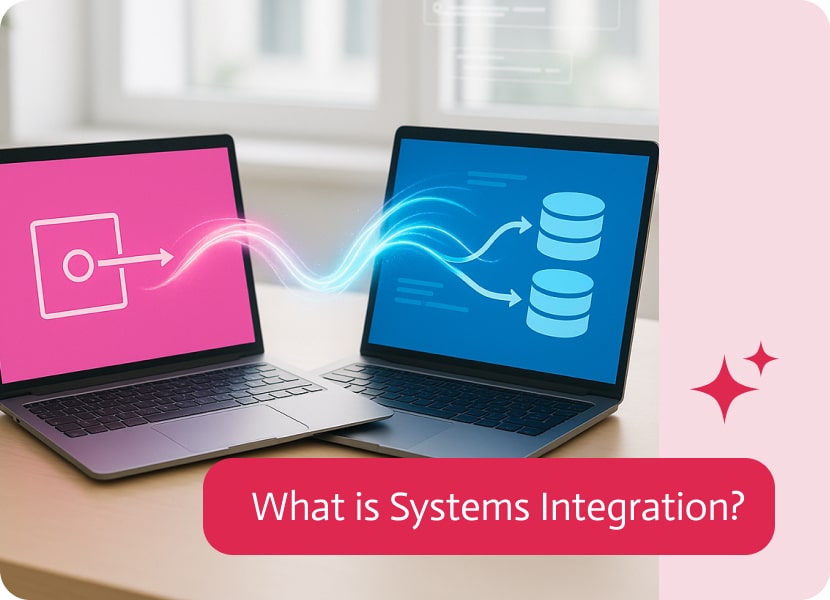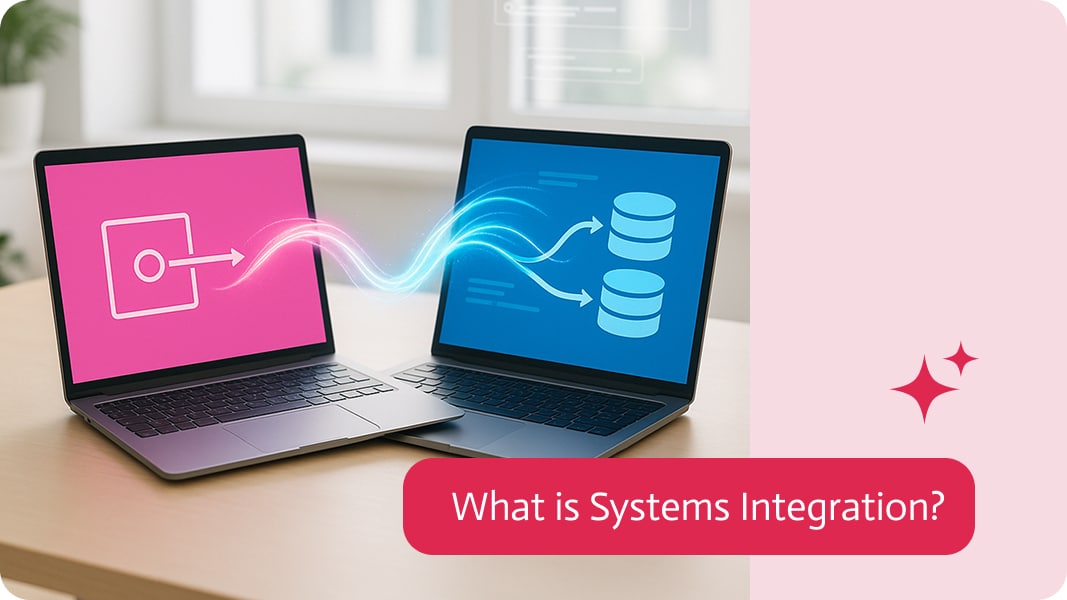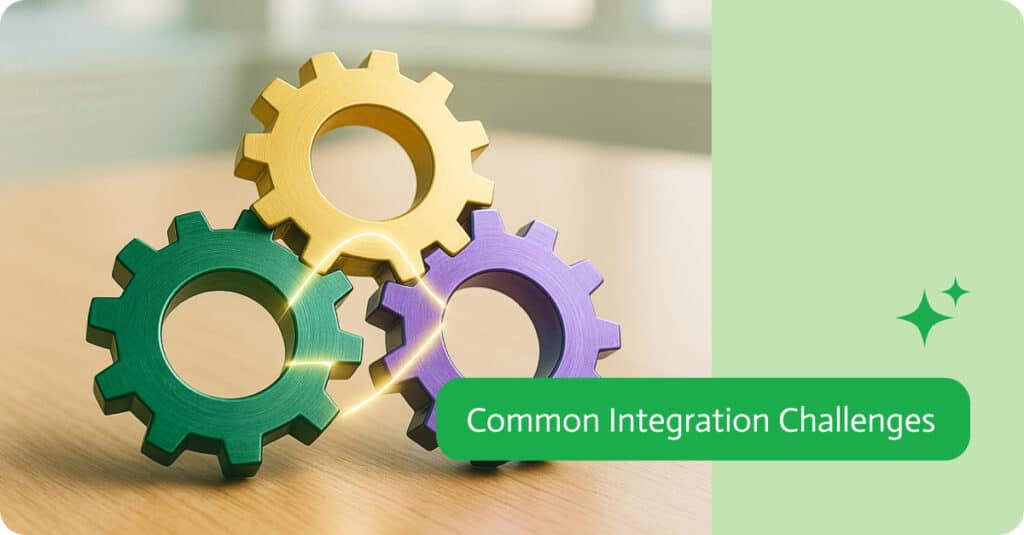

What is Systems Integration?
So here’s what systems integration is in a nutshell. Think of it as magical duct tape, a translator, and diplomat all rolled into one tool. It’s how companies get all their different software systems, apps, databases, and tools to work together like a well-oiled digital machine.
Okay, so your company sales team uses one software application, the marketing team another, HR is on some dusty old platform that screams Windows XP, and finance lives inside a giant spreadsheet lake. Each team’s data is its own little island, and no one’s sending postcards to one another. That’s when system integration comes to the party and brings everyone together, like one big happy family.
Let’s break down what systems integration actually is, why it matters, how it works, and what the future holds, without all the tech jargon.

What Is Systems Integration, Exactly?
Essentially, SI (System Integration) is exactly what it sounds like. Software, hardware, APIs, databases, and basically every different IT system are connected so that they are able to effectively and efficiently communicate with one another. This process of connecting them is what we refer to as System Integration.
We take it for granted these days, but think of that satisfying moment when your calendar automatically adds a Zoom link for a meeting you scheduled in Slack that was based on a Salesforce trigger. That’s systems integration quietly doing its job.
There’s no need for five different apps to operate or function individually and manually feed data to each other. Instead, System Integration facilitates this so everyone plays together nicely.
Why Should We Care About Integration?
We’ve all copy-pasted the same data into three different platforms, emailed a spreadsheet to ourselves because it wasn’t on the computer you were using, or felt the existential dread of mismatched sales numbers, right? Well, that means you’ve experienced life without systems integration.
Here’s why system integration is an essential tool in your companies arsenal:
- Time Saver: System integration allows automation of repetitive tasks. Integrated systems handle all of this automatically, which will almost certainly pump up productivity.
- Error Buster: Typos happen all the time in fast paced environments, and this can lead to major losses in time and money. Things like billing problems, bad counts, and faulty reports can be the cause of the smallest mistakes.
- Data Consistency: The use of multiple systems could lead to inconsistencies in the data. System integration ensures that the same source data is automatically synchronized across all platforms. Consistency is key, as they say.
- Improved Decision Making: In fast-paced business settings, having quick access to true information is crucial. When it comes to marketing campaigns, inventory changes, and resource reallocation, integrated data enables faster and more informed decisions.
- Scalability: Without integration, adding new tools, teams, or workflows often leads to messy workarounds. Scaling is done so much easier when your systems are already built to cooperate. This flexibility allows you to grow while maintaining a clean, efficient operation.
Types of Systems Integration
There’s more than one way to hook things together; here are some of the methods available:
Point-to-Point Integration
System A will talk to system B by using webhooks, API’s and database connections. Each connection is custom-built and set up for smaller systems. Think of this as a direct hotline between two systems. It’s cheap and does okay if you’re only dealing with a couple of tools.
It doesn’t handle scaling well, which will often result in what we like to call a “spaghetti mess.” As the number of integrations increases, it becomes far more difficult to maintain.
Star Integration (aka Hub and Spoke)
This is a system integration approach where each system or component is directly connected to every other system; think point-to-point integrations. It basically forms a pattern that looks like a star, hence the name.
The star integration system allows for incredibly fast communication, which means that data is transferred quickly and reliably.
When it comes to scalability, however, this will turn into a big headache as you increase the number of connections. With more connections comes more maintenance, of course, and if one system updates while the others don’t, well, there’s another headache.
4. iPaaS (Integration Platform as a Service)
iPaaS is a cloud-based tool that connects different applications and data sources without having to build and manage complicated integrations from scratch. Companies like Noca AI are perfect for iPaaS solutions. Essentially, it automates workflows between apps while transforming and mapping data between formats.
There is little to no coding needed (we strongly recommend using completely no-code tools), and it scales easily. It provides centralized monitoring and management and will usually come with built-in security, compliance, and version control.
Benefits of iPaaS
Streamlining Integrations
- iPaaS makes it easier to integrate SaaS apps, legacy systems, data warehouses, APIs, and more without the need for custom code.
- Pre-built connectors and drag-and-drop tools help a lot when it comes to speeding up integration development. Or even use Vibe Integration where you describe your integration in English and let the platform build the integration for you.
Scalability
- iPaaS automatically handles the increased data volumes and users without the need for manual intervention.
- Supports continued growth as new apps and more services are added over time.
Reduced IT Complexity
- Centralized management allows monitoring and control of all the integrations from one dashboard.
- No need to manage on-premises infrastructure or write custom code.
Improved Data Consistency & Accuracy
- Real-time data syncing drastically reduces data duplication and human errors.
- Ensures all systems are working with the same information that is updated in real time.
Cost Efficiency
- By reducing the need for in-house development and maintenance of integrations.
- Subscription-based pricing is often more predictable when compared to the building custom integrations.
Better Security & Compliance
- Centralized governance and security policies ensure a complete overview.
- Data handling complies with regulations like GDPR, HIPAA, ISO 27001, etc., thanks to built-in features.
Common Integration Challenges

Systems integration is a fantastic way to not only increase efficiency but also ramp up productivity. That’s not to say it doesn’t come without any hiccups.
Here are the most common flaws you’ll encounter along the way:
- Data Silos: Older systems don’t like to share or talk to each other. This means that different departments might not be getting the same information or the “truth.’ The solution to this is to simply break them down with APIs and middleware.
- Incompatible Formats: JSON? XML? CSV? How do all the integrations communicate with each other if they’re not even speaking the same language?
- Latency: Some integrations might take longer to process than expected. As you can imagine, time is money. The less time it takes to perform an act, the better it will be for your business. You can solve this by using an iPaaS solution that supports real-time triggers.
- Security Risks: More connections mean more possible entry points for attackers. This is a big problem, especially in our digitally driven economic environment.
- Scope Creep: Integration projects have a funny way of growing like they have a mind of their own, which is caused by many factors. Think unclear initial requirements or that one customer who keeps asking for one more thing to be added to the system.
Real-World Examples of Systems Integration
It’s all good and well in theory, but let’s move to reality:
E-commerce: Online stores link CRMs, shipping platforms, payment processors, and product catalogues. There are a number of systems that are most likely at play when you purchase those shoes.
Healthcare: Electronic health records, lab systems, insurance databases, and appointment scheduling are all integrated in hospitals. It is comparable to medical speed dating.
Banking: Banks use real-time integration to keep everything (mostly) functioning, including fraud detection systems, ATMs, and mobile apps.
Logistics: Real-time package tracking across continents has been made possible thanks to UPS and FedEx’s integrated systems. You can track your package all the time through integration.
The Future of Integration
As businesses embrace microservices, the old-school “one big software system for everything” model is fading. Instead, companies are now starting to stitch together the best-in-class tools for each function, which means that integration is becoming even more crucial.
Some trends to keep an eye out for:
- AI-Driven Integration: Smart systems that detect data patterns and auto-configure integrations, giving you much-needed insight without the hard work.
- Event-Driven Architectures: Instead of polling for updates, systems will be able to react to events in real time.
- Composable Business: Think of it like LEGO for business systems. Simply put, they’re like plug-and-play tools that integrate easily.
- More No-Code Tools: Companies like Noca AI provide you with an army of developers without the devs.
Final Thoughts: Integration Is The Future
Systems integration is the future of any business. Behind every slick customer experience, every automated workflow, and every lightning-fast business decision, there’s a web of integrations working like an underground Chinese sweatshop quietly doing all the heavy lifting.
It’s like anything, for that matter; when it works, you’ll take it for granted and barely notice it, but as soon as it breaks, you feel it instantly.
So whether you’re a startup duct-taping tools together or a big enterprise re-architecting your IT backbone, integration is the glue that holds your tech stack together, and companies like Noca AI are paving the way.


